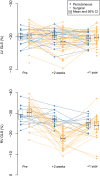Functional Echocardiographic and Serum Biomarker Changes Following Surgical and Percutaneous Atrial Septal Defect Closure in Children
- PMID: 35929457
- PMCID: PMC9496284
- DOI: 10.1161/JAHA.121.024072
Functional Echocardiographic and Serum Biomarker Changes Following Surgical and Percutaneous Atrial Septal Defect Closure in Children
Abstract
Background Ventricular performance is temporarily reduced following surgical atrial septal defect closure. Cardiopulmonary bypass and changes in loading conditions are considered important factors, but this phenomenon is incompletely understood. We aim to characterize biventricular performance following surgical and percutaneous atrial septal defect closure and to relate biomarkers to ventricular performance following intervention. Methods and Results In this multicenter prospective study, children scheduled for surgical or percutaneous atrial septal defect closure were included. Subjects were assessed preoperatively, in the second week postintervention (at 2-weeks follow-up), and 1-year postintervention (1-year follow-up). At each time point, an echocardiographic study and a panel of biomarkers were obtained. Sixty-three patients (median age, 4.1 [interquartile range, 3.1-6.1] years) were included. Forty-three patients underwent surgery. At 2-weeks follow-up, right ventricular global longitudinal strain was decreased for the surgical, but not the percutaneous, group (-17.6±4.1 versus -27.1±3.4; P<0.001). A smaller decrease was noted for left ventricular global longitudinal strain at 2-weeks follow-up for the surgical group (surgical versus percutaneous, -18.6±3.2 versus -20.2±2.4; P=0.040). At 1-year follow-up, left ventricular performance returned to baseline, whereas right ventricular performance improved, but did not reach preintervention levels. Eight biomarkers relating to cardiovascular and immunological processes differed across study time points. Of these biomarkers, only NT-proBNP (N-terminal pro-B-type natriuretic peptide) correlated with less favorable left ventricular global longitudinal strain at 2-weeks follow-up. Conclusions Right, and to a lesser degree left, ventricular performance was reduced early after surgical atrial septal defect closure. Right ventricular performance at 1-year follow-up remained below baseline levels. Several biomarkers showed a pattern over time similar to ventricular performance. These biomarkers may provide insight into the processes that affect ventricular function. Registration URL: https://www.trialregister.nl/; Unique identifier: NL5129.
Keywords: atrial septal defects; biomarkers; cardiopulmonary bypass; congenital heart disease; speckle tracking echocardiography.
Figures
Similar articles
-
Impact of atrial septal defect device size on biventricular global and regional function: a two-dimensional strain echocardiographic study.Cardiol Young. 2022 May;32(5):746-754. doi: 10.1017/S1047951121002948. Epub 2021 Aug 5. Cardiol Young. 2022. PMID: 34348814
-
Hemodynamic improvement is faster after percutaneous ASD closure than after surgery.Catheter Cardiovasc Interv. 2007 Feb 15;69(3):432-41; discussion 442. doi: 10.1002/ccd.20962. Catheter Cardiovasc Interv. 2007. PMID: 17195197
-
Percutaneous device closure of atrial septal defect results in very early and sustained changes of right and left heart function.Int J Cardiol. 2013 Aug 20;167(4):1578-84. doi: 10.1016/j.ijcard.2012.04.081. Epub 2012 May 19. Int J Cardiol. 2013. PMID: 22608895
-
Assessment of right atrial function with speckle tracking echocardiography after percutaneous closure of an atrial septal defect.Rev Port Cardiol. 2017 Dec;36(12):895-900. doi: 10.1016/j.repc.2017.06.013. Epub 2017 Nov 27. Rev Port Cardiol. 2017. PMID: 29191713 English, Portuguese.
-
Cardiovascular events in perimembranous ventricular septal defect with left ventricular volume overload: a French prospective cohort study (FRANCISCO).Cardiol Young. 2021 Oct;31(10):1557-1562. doi: 10.1017/S1047951121002717. Epub 2021 Sep 23. Cardiol Young. 2021. PMID: 34551835 Review.
References
-
- Klitsie LM, Kuipers IM, Roest AA, Van der Hulst AE, Stijnen T, Hazekamp MG, Blom NA, Ten Harkel AD. Disparity in right vs left ventricular recovery during follow‐up after ventricular septal defect correction in children. Eur J Cardiothorac Surg. 2013;44:269–274. doi: 10.1093/ejcts/ezt003 - DOI - PubMed
-
- Klitsie LM, Roest AA, Blom NA, ten Harkel AD. Ventricular performance after surgery for a congenital heart defect as assessed using advanced echocardiography: from Doppler flow to 3D echocardiography and speckle‐tracking strain imaging. Pediatr Cardiol. 2014;35:3–15. doi: 10.1007/s00246-013-0802-5 - DOI - PubMed
Publication types
MeSH terms
Substances
LinkOut - more resources
Full Text Sources
Research Materials


